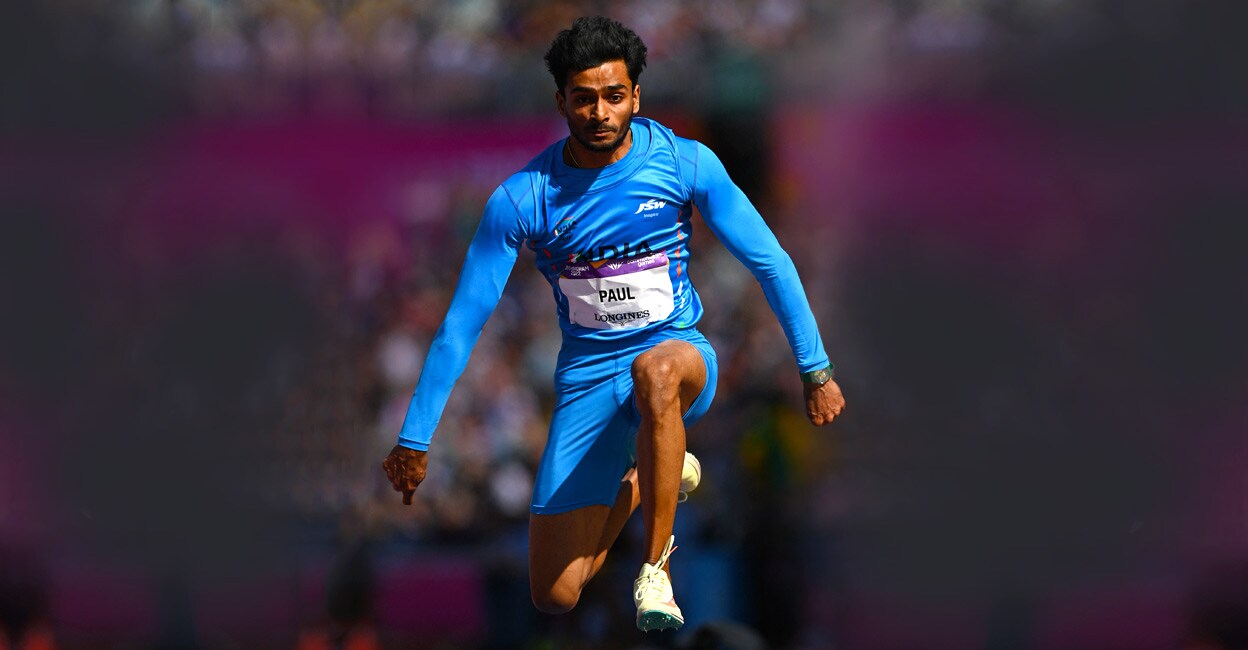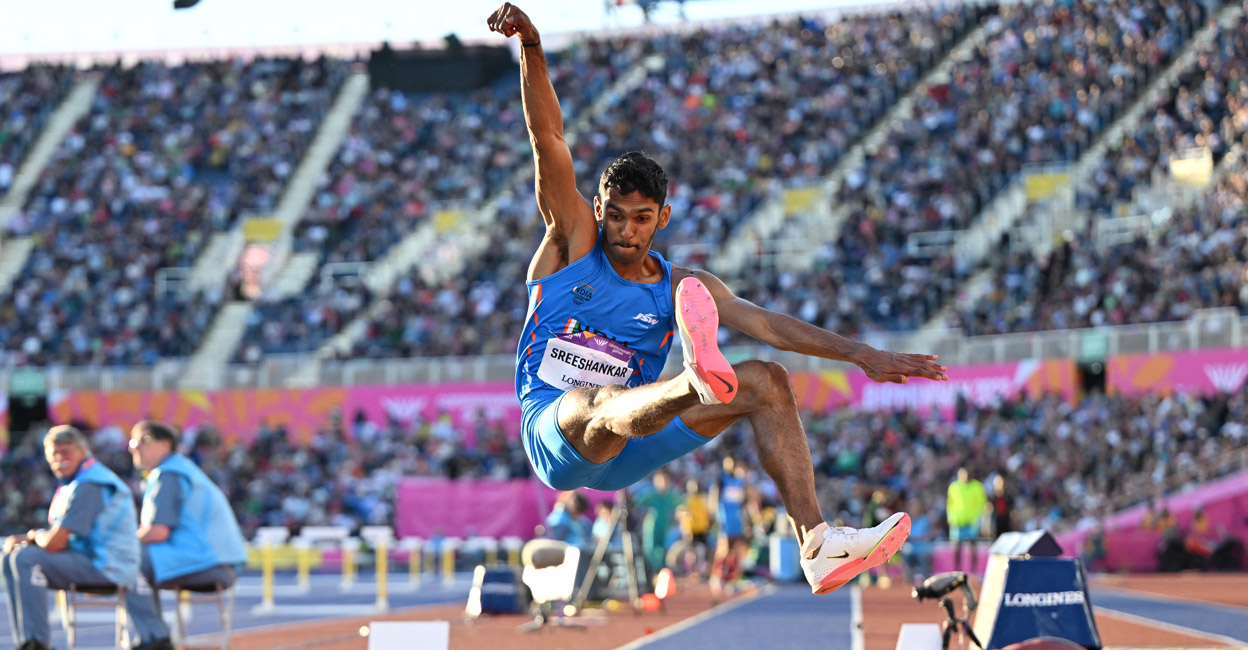Column | Indian athletes have their task cut out

Mail This Article
India’s medal tally of 22 gold, 16 silver and 23 bronze in the recently-concluded Commonwealth Games (CWG) at Birmingham is bound to surprise sports lovers. Though this falls short of the tally of 101 medals in the Delhi edition of the CWG held in 2010 and the 26 golds won at Gold Coast four years ago, the performance is more creditable as shooting, the event that had brought the most medals in the past, was not there this time. More importantly, India could win a gold medal in track and field events, excluding throws, at Birmingham after a very long time. If one discounts the pole position by the women’s 4x400m relay team in 2010, and the achievements of discus and javelin throwers, this was the first time that an Indian athlete won the gold medal in athletics at CWG after Milkha Singh did the honours in 440- yard run at Cardiff in 1958.
Eldhose Paul and Abdulla Aboobacker, who won the gold and silver medals in triple jump, and M Sreeshankar, who came in the second position in long jump, carry forward the Kerala tradition of excelling in the “jumps”. India narrowly missed one more medal in triple jump as Praveen Chitravel lost the bronze by a margin of 3 centimetres. Eldhose cleared 17.03 metres while Abdulla finished 1 centimetre behind, with the third place going to Jah Nhai Perinchief of Bermuda whose leap was measured at 16.92m. Not to be left behind, high jumper Tejaswin Shankar clinched the bronze, clearing a height of 2.22m. Incidentally, this is the first time that India has won a medal in this event at CWG.
The real star for India on the track was Avinash Sable, who won the silver in 3,000m steeplechase for men. Not only was this India’s first medal in this event, but Sable also managed to break the monopoly enjoyed by the Kenyans who had been winning all the three medals in this race since the 1994 edition of CWG. Sable finished with a personal best of 8 minutes and 11.20 seconds, just a shade behind Abraham Kibiwot, who clocked 8:11.15. Among those who bit the dust was Kenyan legend Conseslus Kipruto, the gold medallist at Rio Olympics and CWG 2016 and a former world record holder, who finished sixth. In fact Sable’s final burst took Kibiwot by surprise and many who saw the race felt that the Army man was unfortunate to miss the gold.
All the five - Eldhose, Abdulla, Tejaswin, Sreeshankar and Sable - have spoken about the inspiration they drew from the success achieved by Neeraj Chopra during the last four years. The presence of an Indian athlete on the podium in Olympics had served as a huge morale-booster for the up and coming sportspersons. This was indeed a glass ceiling which took a very long time to be broken. Milkha and P T Usha had come very close to winning a medal but lost out by a fraction of a second, which sort of acted as a mental barrier for Indians aspiring for a podium finish at the biggest of all stages. It appears that the ripple effects caused by Chopra's wins have given a much-needed positive momentum to Indian athletics.

At this juncture, it would be prudent to take a realistic assessment about where Eldhose, Abdulla, Sable and Tejaswin stand in global rankings. Incidentally, Eldhose’s leap of 17.03m at Birmingham was the first time he had cleared the 17m mark, while Abdulla’s career best stands at 17.19m. The world record for this event is held by Jonathan Edwards of Great Britain, who covered a distance of 18.29m, in the World Athletics Championship at Gothenburg in 1995. The Asian record for this event is held by Li Yanxi of China who leapt to 17.59m in the Chinese National Games at Jinan in the first decade of this century. Pedro Pichardo of Portugal took the pole position in 2020 Tokyo Olympics and Zhu Yaming took the silver with leaps of 17.9m, and 17.57m respectively. Thus, it can be seen that our contingent has many more miles to traverse before they can aspire to win medals in Olympics and even in Asian Games.
The situation in high jump is no different with the world record held by Javier Sotomayor of Cuba who cleared a height of 2.45m in 1993. Mutaz Essa Barshim of Qatar and Gianmarco Tamberi of Italy shared the gold at Tokyo 2020 Olympics by clearing 2.37m. Though the bronze medallist at the Jakarta Asian Games of 2018 managed only 2.24m, Wang Yu of China, who won the gold, cleared 2.30m. This will indicate that Tejaswin should not only maintain high levels of consistency but also improve considerably to finish among the top three at the Hangzhou Asian Games next year.

Similar is the case in long jump where competitors have to cover distances exceeding 8.5m consistently to stand a chance of winning medals in Olympic Games. Sreeshankar, who holds the national record with a distance of 8.36m could cover only 8.08m at Birmingham where he came second. World and Olympic records in this event are held by Mike Powell and Bob Beamon with distances of 8.95m and 8.9m respectively. Asian record is held by Mohamed Al Khuwalidi of Saudi Arabia (8.48m) while Wang Jianan of China won the gold at Jakarta Asiad with a leap of 8.24m. Though Sreeshankar has the potential to cover distances exceeding 8.4m, he has not achieved this yet. Further, he has been bogged down by inconsistency as well.
However, the picture does not look so bleak when it comes to 3,000m steeplechase, where the world record of 7:53.63 was set by Saif Saaeed Shaheen of Qatar in 2004. In the last Olympics at Tokyo, bronze medallist Benjamin Kigen of Kenya finished with 8:11.45, which was slower than the the time clocked by Sable at Birmingham. The winner Soufiane El Bakkali of Morocco finished with a time of 8:8.90. The gold medal at Jakarta Asian Games was won by Hossein Keyhani of Iran with a time of 8:22.79.
It will emerge from the above data that while the performance of the five athletes at Birmingham brought plenty of cheer to the sports enthusiasts in our country, they are still a long way from making a serious bid for an Olympic medal. However, the positive mental framework displayed by them when they took part in the competitions brings the hope that they are capable of mounting a serious challenge both at Hangzhou as well as in the Paris Olympics in 2024. This would require bridging of the gap between their current performance levels and that needed for an Olympic medal, acquiring high levels of consistency and the ability to peak at the correct time. Our past experiences show that all these goals can be attained only if these athletes are trained by foreign coaches.
Both Abhinav Bindra and Chopra, the two Indians to win individual Olympic gold medals, had trained under foreign coaches during the run up to the Olympics. Pullella Gopichand, who had coached shuttler P V Sindhu from her early days, had no reservations about getting the services of coaches from Indonesia and South Korea to help her in the quest for gold medal at the World Championships. Without casting any aspersions on the abilities of homegrown coaches and their commitment and skills, one can state with certainty that none of them possess the experience of having guided a sportsperson to the pole position in a top drawer international tournament. Training for Olympic medals involves not only preparing an athlete physically and making him/her mentally strong to approach the event with a positive mindset but also in ensuring that his/her best is reserved for the big occasion. Bindra’s coach Uwe Riesterer sent him for commando training with an army unit as part of the preparation for the Olympics so that he would conquer fear that could grip him during the finals of the event. Present day Indian trainers are unfortunately not equipped with the required skillsets for achieving these ends.
One hopes that the Sports Authority of India invests in foreign coaches to train Eldhose, Abdulla, Tejaswin, Sreeshankar and Sable so that they stand a reasonable chance of making it to the winners podium in Paris. These athletes, on their part, should resist the temptation of sticking to the present set of trainers. Unless they take up the challenge of moving out of their comfort zones by seeking tutelage under coaches from abroad, who are equipped with most modern methods for bringing the best out of their wards, Olympic medals will remain a pipe-dream for this talented lot.
(The author is a former intentional cricket umpire and a senior bureaucrat)


